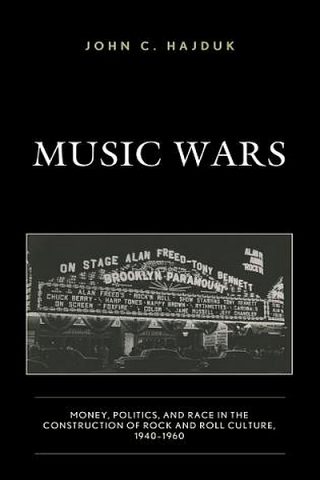“One way to interpret American society in the second half of the twentieth century, for good or ill, is to see it as the triumph of rock and roll culture,” argues John C. Hajduk, professor of history at the University of Montana Western in the book at hand. This peculiar culture was a compelling force “… which promoted everything from youth and conspicuous consumption to individualism, multiculturalism, and civil rights.”
 Hajduk’s main aim is to show the many ways in which (American) music has influenced and often massively changed American society. And not just one generation in the late 1950s, but that this idea of freedom and self-determinism, liberated from the urge to adopt to mainstream society and lead a quiet life as it was common for all age cohorts until then. Music had the power to change and dominate those generations born in the 1960s, 70s, 80s and 90s. However, the book concentrates basically on the years from 1940 until 1960.
Hajduk’s main aim is to show the many ways in which (American) music has influenced and often massively changed American society. And not just one generation in the late 1950s, but that this idea of freedom and self-determinism, liberated from the urge to adopt to mainstream society and lead a quiet life as it was common for all age cohorts until then. Music had the power to change and dominate those generations born in the 1960s, 70s, 80s and 90s. However, the book concentrates basically on the years from 1940 until 1960.
Previous American teenager generations who grew up in the 1930s and 1940s were rather timid and inconspicuous, if compared to the loud, demanding and violent youth of the 1950s “rebels” in juvenile gangs or on motorcycles. Hajduk’s overall impression is not that of a complete revolution; he makes clear that “…it is important to recognize that the ultimate influence of rock and roll was not initially destroying what came before (musically or culturally) but in creating an outlet to express values that were never too far below the surface in American society.”
So some major categories and groups of people are explicitly analyzed: the musicians, the audiences, and the business community. The first group wanted to be innovative and earn money, the second group wanted to be entertained, and the third group also wanted to make money, but they additionally wanted to decide how and when music would be published. Furthermore, this group cherished staying in power (market-wise) and ensuring their mechanisms of controlling the market would stay effective. The author lists plenty of adequately documented examples of companies, labels, radio stations, disc jockeys and executives that prove his point.
Looking back on roughly three decades of strictly monopolized music marketing, starting with Tin Pan Alley hit-making and going over to radio and film promotion of songs, Hajduk paints a very dynamic picture of how a small number of industries for a long time took control over the music market. As radio, sheet music and later film were the major carriers of new songs, early control of those markets and chains of distributions was important. (As recording companies and song publishers were mostly owned by radio networks, who were connected to film studios.) Marketing a (mainstream) song under these circumstances, as the audiences – middle class and upper-middle class – whose moral and cultural tastes were identifiable, was relatively easy.
At the same time, this monopolized process also prohibited major successes of songs and authors outside this circle; African-American singers, authentic cowboy or folklore singers were hardly ever successful in mainstream markets (in the genres of popular music and light classics; jazz, however, was a very different thing.)
So very few “gatekeepers,” as Hajduk calls them, in the music industry and related publishers, on results based on telephone surveys actually decided what music or genre would get airtime, to appeal to the majority of listeners. This artificially made mainstream in the 1930s and 1940s did not leave room for independent music, exotic artists or even subcultural forms of musical expression. Music as played on the radio at that time was simply a product, with no relation to regional or local music traditions. For a certain time, especially before and during WWII, popular music also was supposed to play an important role – besides being a light diversion that was easily available – in informing, upholding and promoting national/moral American values.
The long and tedious process that ultimately changed American music and American society in the 1950s is another subject of this book (even as the author states that this topic has been treated successfully before and that he could not offer any new insights.) But as Hajduk in great detail and through many illustrations demonstrates, then (popular) music slowly was beginning to be associated with social change, social progress and even rebellious attitudes; an impossibility during the war years.
This change would later be identified as the core of a “rock and roll culture.” It would contain “a coherent set of values related to concepts of youth, authenticity, sexual liberation, and social equality that emerged by the end of the 1950s.”
A very interesting and well-documented study of a network of gatekeepers in the industry; even if this specific topic may bore some readers who are more interested in post-war cultural criticism.
Review by Dr. A. Ebert © 2019
John C. Hajduk. Music Wars: Money, Politics, and Race in the Construction of Rock and Roll Culture, 1940-1960, Lexington Books, 2018, 216 p.
